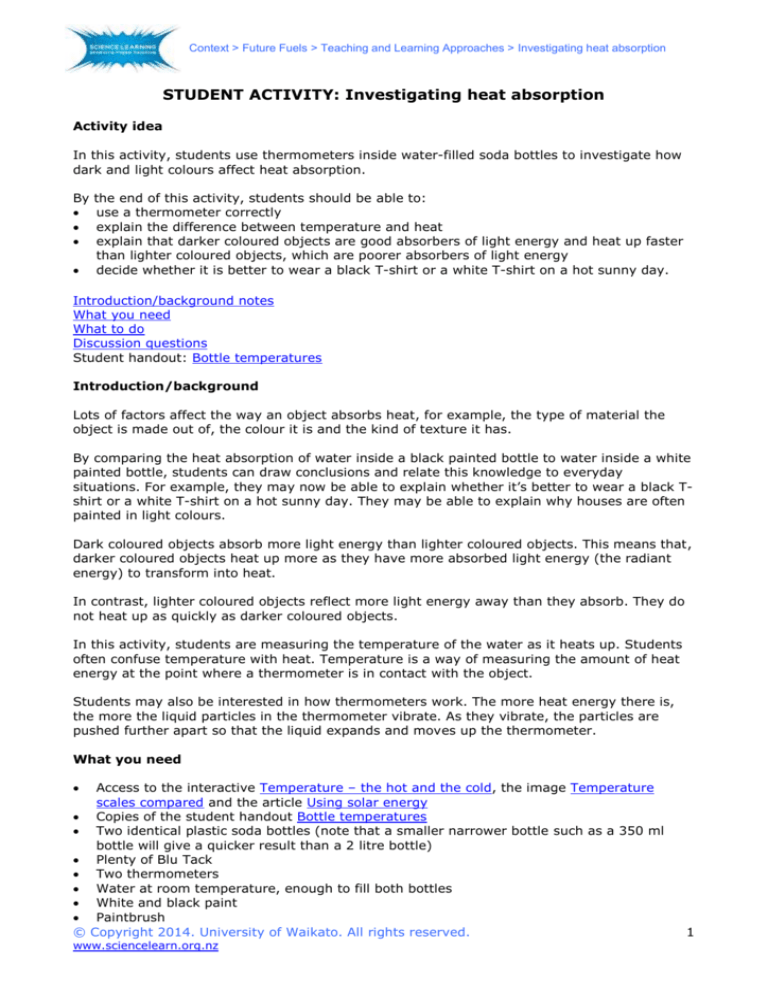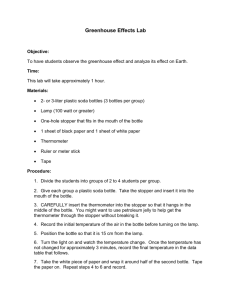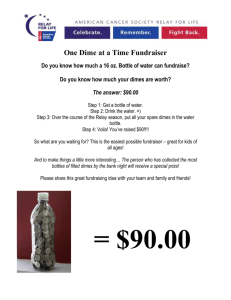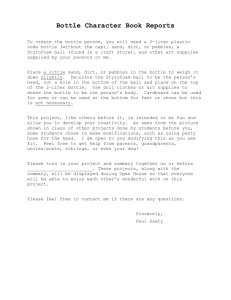
Context > Future Fuels > Teaching and Learning Approaches > Investigating heat absorption
STUDENT ACTIVITY: Investigating heat absorption
Activity idea
In this activity, students use thermometers inside water-filled soda bottles to investigate how
dark and light colours affect heat absorption.
By
the end of this activity, students should be able to:
use a thermometer correctly
explain the difference between temperature and heat
explain that darker coloured objects are good absorbers of light energy and heat up faster
than lighter coloured objects, which are poorer absorbers of light energy
decide whether it is better to wear a black T-shirt or a white T-shirt on a hot sunny day.
Introduction/background notes
What you need
What to do
Discussion questions
Student handout: Bottle temperatures
Introduction/background
Lots of factors affect the way an object absorbs heat, for example, the type of material the
object is made out of, the colour it is and the kind of texture it has.
By comparing the heat absorption of water inside a black painted bottle to water inside a white
painted bottle, students can draw conclusions and relate this knowledge to everyday
situations. For example, they may now be able to explain whether it’s better to wear a black Tshirt or a white T-shirt on a hot sunny day. They may be able to explain why houses are often
painted in light colours.
Dark coloured objects absorb more light energy than lighter coloured objects. This means that,
darker coloured objects heat up more as they have more absorbed light energy (the radiant
energy) to transform into heat.
In contrast, lighter coloured objects reflect more light energy away than they absorb. They do
not heat up as quickly as darker coloured objects.
In this activity, students are measuring the temperature of the water as it heats up. Students
often confuse temperature with heat. Temperature is a way of measuring the amount of heat
energy at the point where a thermometer is in contact with the object.
Students may also be interested in how thermometers work. The more heat energy there is,
the more the liquid particles in the thermometer vibrate. As they vibrate, the particles are
pushed further apart so that the liquid expands and moves up the thermometer.
What you need
©
Access to the interactive Temperature – the hot and the cold, the image Temperature
scales compared and the article Using solar energy
Copies of the student handout Bottle temperatures
Two identical plastic soda bottles (note that a smaller narrower bottle such as a 350 ml
bottle will give a quicker result than a 2 litre bottle)
Plenty of Blu Tack
Two thermometers
Water at room temperature, enough to fill both bottles
White and black paint
Paintbrush
Copyright 2014. University of Waikato. All rights reserved.
www.sciencelearn.org.nz
1
Context > Future Fuels > Teaching and Learning Approaches > Investigating heat absorption
What to do
1. Discuss with your class that thermometers are a way of measuring heat energy – ‘thermo’
meaning warm and ‘meter’ meaning to measure. The interactive Temperature – the hot
and the cold or the image Temperatures scales compared may be helpful to refer to for this
discussion on the measurement scale:
What scale do we use? (Degrees Celsius °C)
Where does it start? (-273°C)
What can it go to? (2000°C)
What is the standard room temperature? (25°C)
Has the doctor taken your temperature? What was it? What is the normal temperature
of people? (37°C)
What is the range of temperature that your classroom thermometers measure?
2. Hand out copies of the student handout Bottle temperatures and discuss. Assist students to
gather the materials they need and conduct the experiment.
3. Discuss their findings.
Which thermometer had the greatest change in temperature?
Which thermometer showed the fastest increase in temperature?
What absorbs heat better – the black painted bottle or the white coloured bottle?
Ask your students to read the paragraph on heating in th article Using solar energy. Do
the results of their investigation support this?
Would you prefer to wear a black T-shirt or a white T-shirt on a hot sunny day?
© Copyright 2014. University of Waikato. All rights reserved.
www.sciencelearn.org.nz
2
Context > Future Fuels > Teaching and Learning Approaches > Investigating heat absorption
Student handout: Bottle temperatures
1. Paint the outside of one bottle white and the outside of the other bottle black. Set aside to
dry.
2. Take the dry bottles and fill with room temperature water.
3. Take the bottle caps. Make a hole in each cap, big enough to insert the thermometer.
4. Shake the thermometers (carefully) to get the liquid down near 0°C.
5. Place a thermometer in each cap so that, when it is in the bottle, it’s immersed in the
water. Use Blu Tack to create a seal around the thermometer and to keep it in place.
6. Place the bottles in a sunny location, such as inside near a window in direct sunlight.
7. Record the initial temperature.
8. Continue recording the temperature from both bottles every 5 minutes. The time it takes
for the water to heat will depend on the intensity of the sunlight and the volume of water.
9. Continue monitoring the temperatures until a constant temperature is reached in either
bottle. A constant temperature is achieved when no change in temperature is recorded in
two subsequent readings.
10. Repeat twice and compare your readings.
© Copyright 2014. University of Waikato. All rights reserved.
www.sciencelearn.org.nz
3









